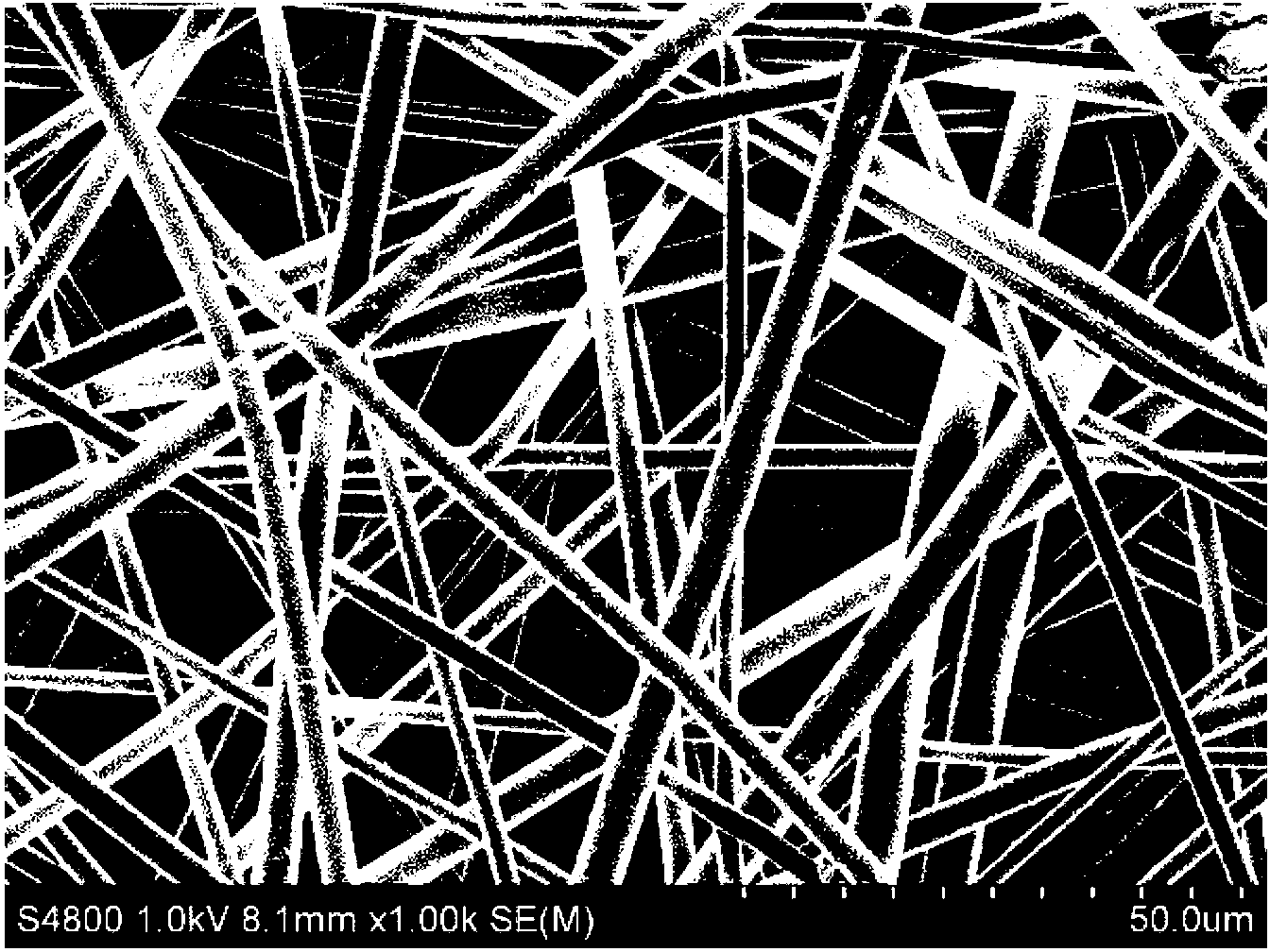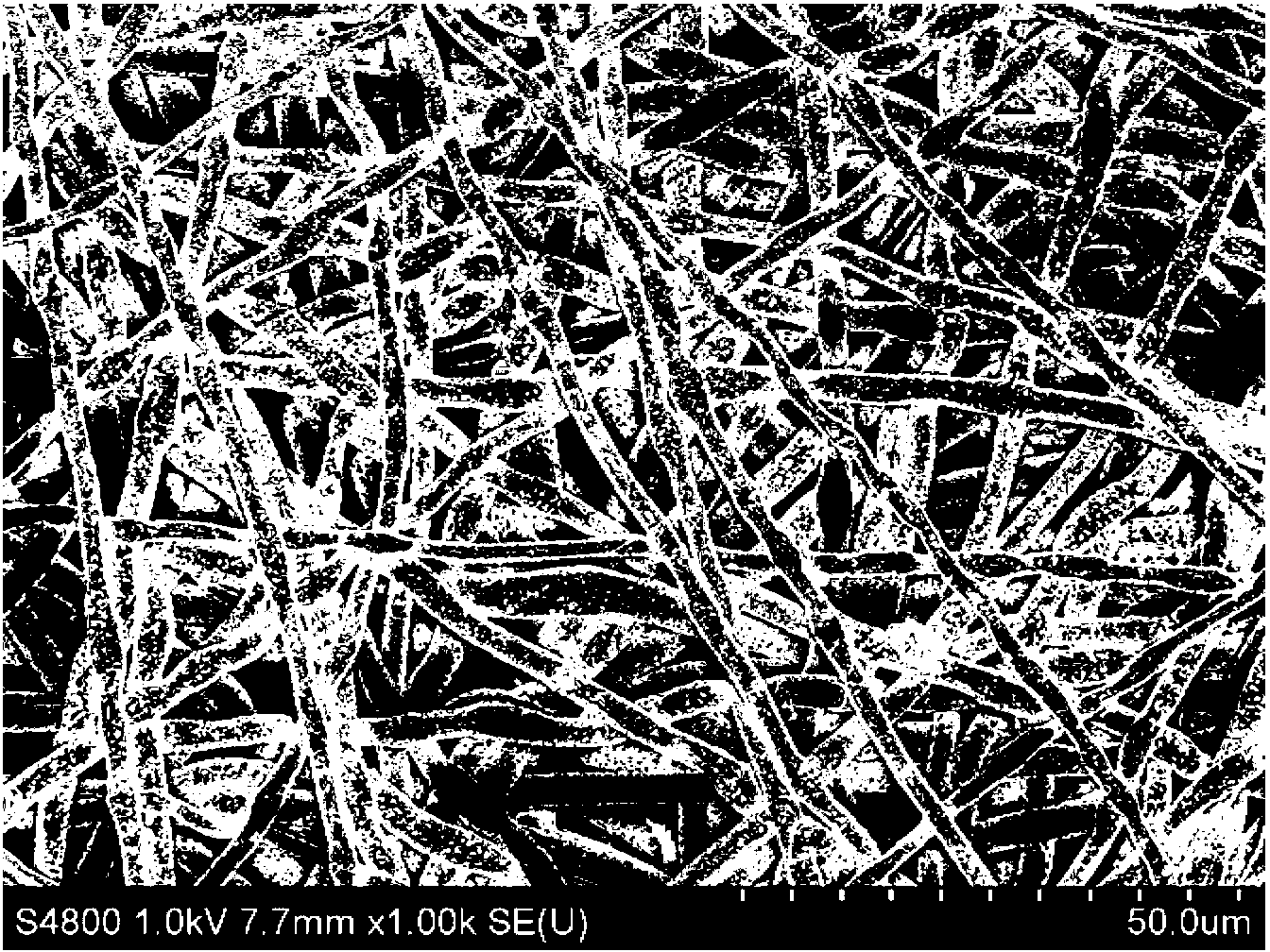Aliphatic polyester double-layered asymmetric guided tissue regeneration membrane and preparation method thereof
A technology for guiding tissue regeneration and aliphatic polyester, applied in medical science, surgery, etc., can solve the problems of complex post-processing measures, difficult control of membrane pore size, low spinning and molding efficiency, etc. The effect of good interlayer bonding and simple preparation method
- Summary
- Abstract
- Description
- Claims
- Application Information
AI Technical Summary
Problems solved by technology
Method used
Image
Examples
Embodiment 1
[0024] 1. Dissolve 1.411g of racemic polylactic acid (PDLLA) with a viscosity average molecular weight of 200,000 in a mixed solvent of 9ml of chloroform and 1ml of N,N-dimethylformamide, and magnetically stir at room temperature for 12 hours to obtain a concentration of 9% (w / w) polylactic acid electrospinning solution, stand at room temperature to defoam; dissolve 2.000g of polylactic acid glycolic acid copolymer (PLGA, molar ratio 50:50) with a viscosity average molecular weight of 130,000 in 8ml tetrahydrofuran and 2mlN , In a mixed solvent of N-dimethylformamide, magnetically stirred at room temperature for 12 hours to obtain a polylactic acid glycolic acid copolymer electrospinning solution with a concentration of 0.2g / ml, and let it stand at room temperature to defoam;
[0025] 2. Add the polylactic acid electrospinning solution prepared in step 1 to the reservoir for electrospinning. The starting voltage is 15KV, the receiving distance is 15cm, and the liquid output rate i...
Embodiment 2
[0032] 1. Dissolve 1.074g of racemic polylactic acid (PDLLA) with a viscosity average molecular weight of 406,000 in a mixed solvent of 9ml of chloroform and 1ml of N,N-dimethylformamide, and magnetically stir at room temperature for 12 hours to obtain a concentration of 7% (w / w) polylactic acid electrospinning solution, defoaming at room temperature;
[0033] 2. Take 5ml of the polylactic acid electrospinning solution prepared in step 1 and add it to the reservoir for electrospinning. The spinning conditions are: voltage 15KV, receiving distance 20cm, output rate 7ml / h, receiving device with tin foil attached to the surface The rotating stainless steel disc (diameter 100mm), the disc speed is 300rpm, and the polylactic acid electrospun membrane with a diameter of 100mm and a thickness of 0.2mm is obtained;
[0034] 3. Place the polylactic acid electrospun membrane obtained in step 2 between two flat plates with fine patterns on the inner surface and the other without patterns on t...
Embodiment 3
[0040] 1. Dissolve 1.074g of racemic polylactic acid (PDLLA) with a viscosity average molecular weight of 406,000 in a mixed solvent of 9ml of chloroform and 1ml of N,N-dimethylformamide, and magnetically stir at room temperature for 12 hours to obtain a concentration of 7% (w / w) polylactic acid electrospinning solution, let stand at room temperature for defoaming; Dissolve 1.411g racemic polylactic acid (PDLLA) with a viscosity average molecular weight of 200,000 in 9ml chloroform and 1ml N,N-dimethylformaldehyde In a mixed solvent of amide, magnetically stirred at room temperature for 12 hours to obtain a polylactic acid electrospinning solution with a concentration of 9% (w / w), and let it stand at room temperature to defoam;
[0041] 2. Add the polylactic acid electrospinning solution with a concentration of 7% (w / w) prepared in step 1 to the reservoir for electrospinning. The starting voltage is 15KV, the receiving distance is 20cm, and the liquid output rate is 7ml / h. The r...
PUM
| Property | Measurement | Unit |
|---|---|---|
| thickness | aaaaa | aaaaa |
| thickness | aaaaa | aaaaa |
| thickness | aaaaa | aaaaa |
Abstract
Description
Claims
Application Information
 Login to View More
Login to View More - Generate Ideas
- Intellectual Property
- Life Sciences
- Materials
- Tech Scout
- Unparalleled Data Quality
- Higher Quality Content
- 60% Fewer Hallucinations
Browse by: Latest US Patents, China's latest patents, Technical Efficacy Thesaurus, Application Domain, Technology Topic, Popular Technical Reports.
© 2025 PatSnap. All rights reserved.Legal|Privacy policy|Modern Slavery Act Transparency Statement|Sitemap|About US| Contact US: help@patsnap.com


